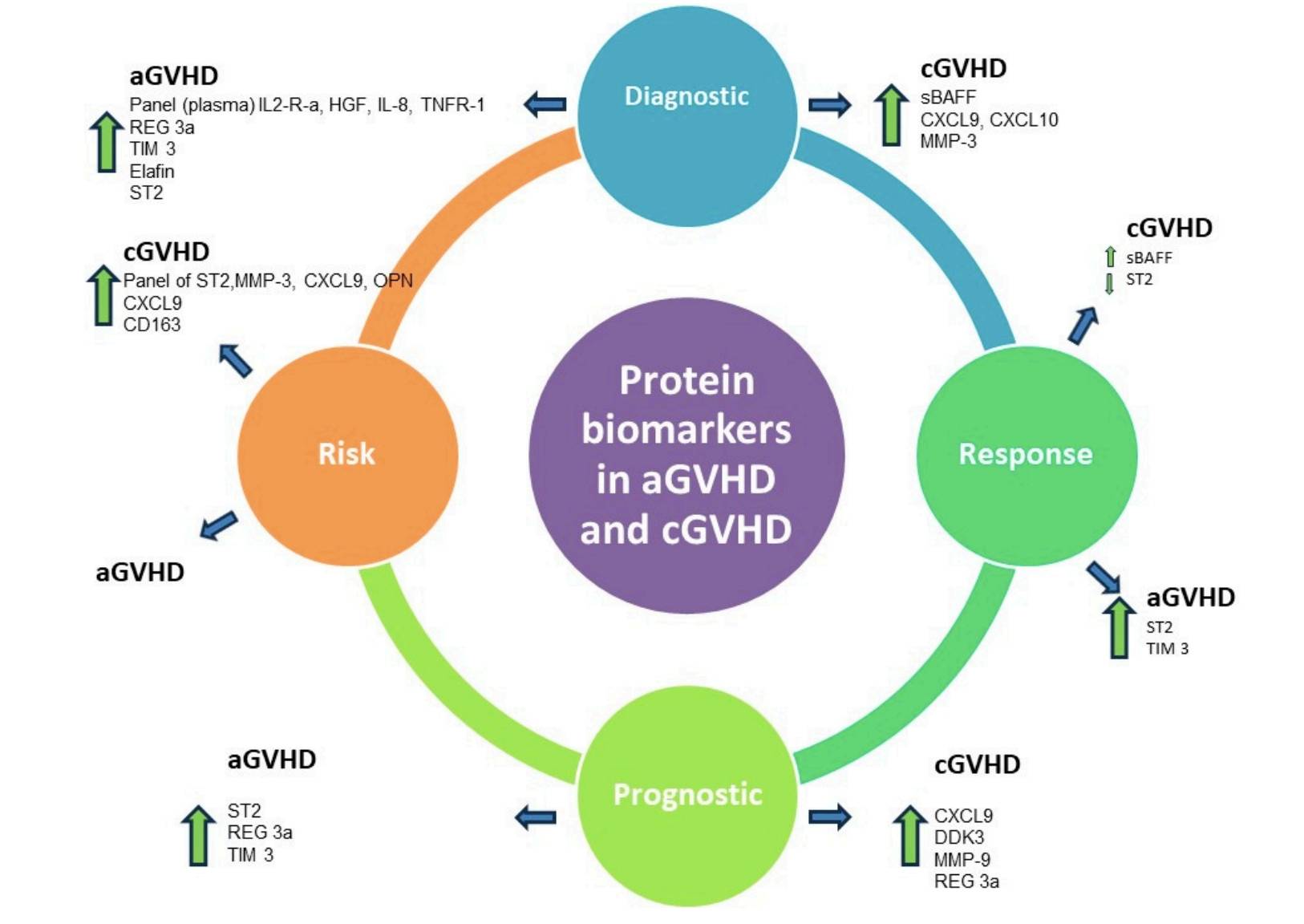GVHD Prediction System based on Protein-Level Markers
Biomarkers are key to discovering and developing novel therapies for GVHD. They can be used for risk assessment, diagnosis, prognosis, and to determine treatment effectiveness, safety, or recurrence. Creative Biolabs provides biomarker discovery services for GVHD prediction and development and manufacturing services for in vitro immunodiagnostics. We have established a unique mass spectrometry proteomics and big data-driven analysis platform, significantly shortening the discovery cycle of GVHD markers. According to the characteristics of the protein-level biomarkers, the corresponding GVHD diagnosis platform is adapted to realize the closed-loop path of rapid productization.
Introduction
GVHD is a pathological syndrome resulting from the attack of donor lymphocytes on the recipient's organs following allogeneic hematopoietic stem cell transplantation. It represents the most prevalent complication and leading cause of mortality post-transplantation. Currently, there is a dearth of predictive biomarkers for GVHD in clinical practice, with most being confined to animal experiments and small sample studies. Consequently, Creative Biolabs has established a biomarker development platform for predicting GVHD on protein levels, offering an array of services for GVHD protein level biomarker discovery, assessment, and validation to aid in monitoring the onset and progression of GVHD as well as determining prognosis and facilitating early treatment.
Providing biomarker solutions for predicting GVHD protein levels, we aim to improve diagnostic procedures, detect prognosis, and predict outcomes. Our services include an accurate assessment of GVHD cell biological functions and an understanding of the molecular pathogenesis of GVHD to develop new therapeutic strategies and targets.
 Fig.1 Protein Markers in Graft-Versus-Host Disease (GVHD).1
Fig.1 Protein Markers in Graft-Versus-Host Disease (GVHD).1
Services
Biomarkers play an important role in GVHD research. At present, the vast majority of GVHD is still diagnosed at an advanced stage, missing the best opportunity for treatment. With the development of proteomics technology, extensive exploration of GVHD biomarkers began, and many protein molecules are potential GVHD biomarkers.
Our GVHD protein level-related predictive marker technology platform is primarily categorized into three aspects: systemic biomarkers, organ-specific biomarkers, and biomarker groups. Among these, our focus lies on the relationship between cytokines and their receptors in predicting and diagnosing GVHD, particularly due to the cytokine storms caused by donor cells early after infusion. Within our laboratory, the most prominent cytokine involved in predicting aGVHD is the soluble IL-2 receptor (sIL-2R). Additionally, we have explored the predictive value of ceruloplasmin for GVHD by continuously monitoring serum levels post-transplantation as it acts as an acute phase reactive protein with antioxidant effects that may negatively regulate cytokine storms during GVHD occurrence. Furthermore, LIGHT/HVEM represents a pair of co-stimulatory molecules crucial in T cell activation and effector phase, playing significant roles in transplantation rejection and GVHD.
|
Types
|
Protein-Level GVHD Prediction Biomarkers
|
|
Systemic Biomarkers
|
Endothelial injury markers: plasma von Willebrand factor (vWF), serum soluble adhesion molecules, serum VACM-1 and CD62E levels, angiopoietin-2 (Ang-2), chemokine IL8 (CXCL8), endothelial microparticles (EPM), circulating endothelial cells (CECs).
|
|
Organ-Specific Biomarkers
|
Lower digestive tract biomarkers: REG3a, CK-18, S100, Tim-3;
Liver-specific biomarker: Hepatocyte Growth Factor (HGF);
Skin specific biomarker: Elafin.
|
|
Biomarker Groups
|
1) IL-6, sTNFR1, ST2;
2) IL-2Ra, HGF, IL-8, elafin, REG3a;
3) TNFR1, ST2, REG3a;
4) CD4 + T cell, CD8 + T cell, CD4/CD8 Tcell ratio, IL-2R.
|
Recently, with the development of our proteomic analysis systems, we have been able to provide high-performance analyses with large samples to find many predictive markers of GVHD protein levels, such as Elafin, Reg3α, and calretinin. In addition, because the prediction effect of a single marker on GVHD is easily interfered with by many factors, its application has certain limitations. Therefore, we established a combined system of several markers to improve GVHD pre-performance. For example, by measuring serum levels of IL-2Rα, TNFR1, IL-8, and hepatocyte growth factor (HGF), we can not only predict the occurrence of aGVHD but also screen out high-risk groups in patients with GVHD and predict their prognosis.
Advantages
-
Extensive validation with strict statistical criteria to reduce the occurrence of false positive results;
-
Combined detection of multiple GVHD protein level biomarkers can further improve the accuracy of disease diagnosis;
-
High standard reproducibility of biomarkers for GVHD protein levels with different biological samples, different sample batches, and different laboratory sources.
Proteomic techniques for GVHD biomarker discovery are constantly evolving. Creative Biolabs is pioneering the development of early-onset predictive biomarkers for GVHD based on MS and HPLC technologies. We take a multi-omics approach that can effectively and quickly translate candidate biomarkers from the laboratory to preclinical. If you are interested in our services, please feel free to contact us.
Reference
-
Alexoudi, Vaia-Aikaterini, et al. "Graft-Versus-Host Disease: Can Biomarkers Assist in Differential Diagnosis, Prognosis, and Therapeutic Strategy?." Pharmaceuticals 17.3 (2024): 298.
For Research Use Only | Not For Clinical Use


 Fig.1 Protein Markers in Graft-Versus-Host Disease (GVHD).1
Fig.1 Protein Markers in Graft-Versus-Host Disease (GVHD).1
 Download our brochure
Download our brochure